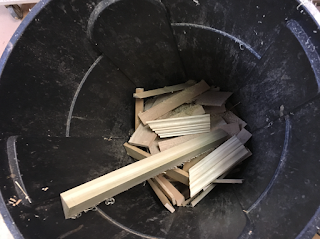In my previous post I illustrated the execution of a
few simple profiles: one concave, convex and flat surface. These modest
profiles illustrate the necessary series of steps for guiding hollow and round
planes, which have neither fence nor depth stop and are seemingly difficult to
steer. Know that hollows and rounds are always guided in the same fashion I
presented there, even when making something more intricate.
The process can seem daunting with more complex profiles. A
sober mind will soon conclude that the same process, once learned, understood
and tried will apply there, here and everywhere.
Hollows will ride the edges of a chamfer to create a convex
surface and rounds will ride the edges of a rabbet(s) to make concave faces.
Combining these attributes to guide various hollows and rounds will allow you,
the end user, to make increasingly complex profiles.
See if you recognize any portion of the process with the
following moulding from E. J. Warne’s Furniture
Moulding.
When preparing to make this moulding we must first transfer
the profile from paper onto wood. Step 1 is “find the flats” of the profile.
From here, having already used a circle template to find the
various radii of the circle segments involved, connect the flat surfaces and
then add an appropriate series of rabbets for every round to be used.
Once defined, transfer the rabbets to the ends of the final
piece and knock off the bulk of the material with your favorite method. If this
is a big leap, see here.
All of these rabbets must first be defined with a rabbet
plane or other preferred method. See how I did this here.
Start knocking off the edges of those rabbets with the appropriately sized rounds. I used #14 round first.
The round has no fence and no depth stop which, again, is an
absolute advantage of the tool. These planes will ride in the rabbets which serve
three purposes: removing the bulk of material with an edge that is easiest to
maintain, creating a series of chutes for the planes to ride in that substitute
for a fence, and giving the user a defined goal that will be a depth gauge.
Add a chamfer for the #10 hollow.
#6 round is next, guided by rabbets
Finally, chamfers to guide the #4 hollow
All that is left is a poor miter, a drink,
and a reiteration that the process of steering these planes is easy because it is always the same.

























































